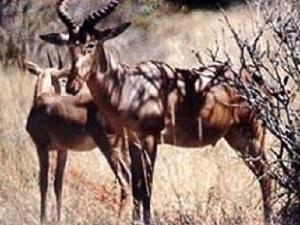Solomon Kyalo
The Hirola Antelope, found only in the Garissa and Tana River districts of Kenya, is critically endangered; Solomon Kyolo will document traditional knowledge of the Hirola to explain the past population decline and develop conservation measures.

An adult male and sub-adult female Hirola Antelope on a recently burnt livestock grazing site.
The Hirola Antelope, found only in the Garissa and Tana River districts of Kenya, is critically endangered. Only a small population of perhaps 1500-2000 individuals remains, despite efforts in the past to transplant populations to other areas such as the Tsavo East National Park. In-situ conservation is now seen as the species' best hope for survival.
This project aims to strengthen recent conservation efforts by the local communities through integrating traditional and scientific knowledge of the species. By working with existing conservation groups in the Hirola's home range, Solomon Kyolo will document traditional knowledge of the Hirola to explain the past population decline. He will investigate local communities' perceptions of the Hirola and its place within their culture and explore how these have changed with time. The objective is to use this traditional knowledge to identify and recommend interventions and strategies towards Hirola recovery and explore how to develop community conservation measures.